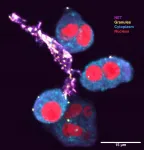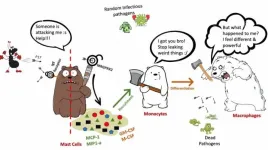(Press-News.org) A diet rich in fermented foods enhances the diversity of gut microbes and decreases molecular signs of inflammation, according to researchers at the Stanford School of Medicine.
In a clinical trial, 36 healthy adults were randomly assigned to a 10-week diet that included either fermented or high-fiber foods. The two diets resulted in different effects on the gut microbiome and the immune system.
Eating foods such as yogurt, kefir, fermented cottage cheese, kimchi and other fermented vegetables, vegetable brine drinks, and kombucha tea led to an increase in overall microbial diversity, with stronger effects from larger servings. "This is a stunning finding," said Justin Sonnenburg, PhD, an associate professor of microbiology and immunology. "It provides one of the first examples of how a simple change in diet can reproducibly remodel the microbiota across a cohort of healthy adults."
In addition, four types of immune cells showed less activation in the fermented-food group. The levels of 19 inflammatory proteins measured in blood samples also decreased. One of these proteins, interleukin 6, has been linked to conditions such as rheumatoid arthritis, Type 2 diabetes and chronic stress.
"Microbiota-targeted diets can change immune status, providing a promising avenue for decreasing inflammation in healthy adults," said Christopher Gardner, PhD, the Rehnborg Farquhar Professor and director of nutrition studies at the Stanford Prevention Research Center. "This finding was consistent across all participants in the study who were assigned to the higher fermented food group."
Microbe diversity stable in fiber-rich diet
By contrast, none of these 19 inflammatory proteins decreased in participants assigned to a high-fiber diet rich in legumes, seeds, whole grains, nuts, vegetables and fruits. On average, the diversity of their gut microbes also remained stable. "We expected high fiber to have a more universally beneficial effect and increase microbiota diversity," said Erica Sonnenburg, PhD, a senior research scientist in basic life sciences, microbiology and immunology. "The data suggest that increased fiber intake alone over a short time period is insufficient to increase microbiota diversity."
The study will be published online July 12 in Cell. Justin and Erica Sonnenburg and Christopher Gardner are co-senior authors. The lead authors are Hannah Wastyk, a PhD student in bioengineering, and former postdoctoral scholar Gabriela Fragiadakis, PhD, who is now an assistant professor of medicine at UC-San Francisco.
A wide body of evidence has demonstrated that diet shapes the gut microbiome, which can affect the immune system and overall health. According to Gardner, low microbiome diversity has been linked to obesity and diabetes.
"We wanted to conduct a proof-of-concept study that could test whether microbiota-targeted food could be an avenue for combatting the overwhelming rise in chronic inflammatory diseases," Gardner said.
The researchers focused on fiber and fermented foods due to previous reports of their potential health benefits. While high-fiber diets have been associated with lower rates of mortality, the consumption of fermented foods can help with weight maintenance and may decrease the risk of diabetes, cancer and cardiovascular disease.
The researchers analyzed blood and stool samples collected during a three-week pre-trial period, the 10 weeks of the diet, and a four-week period after the diet when the participants ate as they chose.
The findings paint a nuanced picture of the influence of diet on gut microbes and immune status. On one hand, those who increased their consumption of fermented foods showed similar effects on their microbiome diversity and inflammatory markers, consistent with prior research showing that short-term changes in diet can rapidly alter the gut microbiome. On the other hand, the limited change in the microbiome within the high-fiber group dovetails with the researchers' previous reports of a general resilience of the human microbiome over short time periods.
Designing a suite of dietary and microbial strategies
The results also showed that greater fiber intake led to more carbohydrates in stool samples, pointing to incomplete fiber degradation by gut microbes. These findings are consistent with other research suggesting that the microbiome of people living in the industrialized world is depleted of fiber-degrading microbes.
"It is possible that a longer intervention would have allowed for the microbiota to adequately adapt to the increase in fiber consumption," Erica Sonnenburg said. "Alternatively, the deliberate introduction of fiber-consuming microbes may be required to increase the microbiota's capacity to break down the carbohydrates."
In addition to exploring these possibilities, the researchers plan to conduct studies in mice to investigate the molecular mechanisms by which diets alter the microbiome and reduce inflammatory proteins. They also aim to test whether high-fiber and fermented foods synergize to influence the microbiome and immune system of humans. Another goal is to examine whether the consumption of fermented food decreases inflammation or improves other health markers in patients with immunological and metabolic diseases, and in pregnant women and older individuals.
"There are many more ways to target the microbiome with food and supplements, and we hope to continue to investigate how different diets, probiotics and prebiotics impact the microbiome and health in different groups," Justin Sonnenburg said.
INFORMATION:
Other Stanford co-authors are Dalia Perelman, health educator; former graduate students Dylan Dahan, PhD, and Carlos Gonzalez, PhD; graduate student Bryan Merrill; former research assistant Madeline Topf; postdoctoral scholars William Van Treuren, PhD, and Shuo Han, PhD; Jennifer Robinson, PhD, administrative director of the Community Health and Prevention Research Master's Program and program manager of the Nutrition Studies Group; and Joshua Elias, PhD.
Researchers from Chan-Zuckerberg Biohub also contributed to the study.
The work was supported by donations to the Center for Human Microbiome Research; Paul and Kathy Klingenstein; the Hand Foundation; Heather Buhr and Jon Feiber; Meredith and John Pasquesi; the National Institutes of Health (grant T32 AI 7328-29); a Stanford Dean's Postdoctoral Fellowship; a National Science Foundation Graduate Student Fellowship; and seed funding from the Institute for Immunity, Transplantation and Infection and from the Sean N. Parker Center for Allergy and Asthma Research.
The Stanford University School of Medicine consistently ranks among the nation's top medical schools, integrating research, medical education, patient care and community service. For more news about the school, please visit http://med.stanford.edu/school.html. The medical school is part of Stanford Medicine, which includes Stanford Health Care and Stanford Children's Health. For information about all three, please visit http://med.stanford.edu.
You're as old as your immune system.
Investigators at the Stanford University School of Medicine and the Buck Institute for Research on Aging have built an inflammatory-aging clock that's more accurate than the number of candles on your birthday cake in predicting how strong your immune system is, how soon you'll become frail or whether you have unseen cardiovascular problems that could become clinical headaches a few years down the road.
In the process, the scientists fingered a bloodborne substance whose abundance may accelerate cardiovascular aging.
The story of the clock's creation will be published July 12 in Nature Aging.
"Every year, the calendar tells us we're a year older," said David ...
The cave of Satsurblia was inhabited by humans in different periods of the Paleolithic: Up to date a single human individual dated from 15,000 years ago has been sequenced from that site. No other human remains have been discovered in the older layers of the cave.
The innovative approach used by the international team led by Prof. Ron Pinhasi and Pere Gelabert with Susanna Sawyer of the University of Vienna in collaboration with Pontus Skoglund and Anders Bergström of the Francis Crick Institute in London permits the identification of DNA in samples of environmental ...
Boosting the body's own disease-fighting immune pathway could provide answers in the desperate search for new treatments for tuberculosis.
Tuberculosis still represents an enormous global disease burden and is one of the top 10 causes of death worldwide.
Led by WEHI's Dr Michael Stutz and Professor Marc Pellegrini and published in Immunity, the study uncovered how cells infected with tuberculosis bacteria can die, and that using new medicines to enhance particular forms of cell death decreased the severity of the disease in a preclinical model.
At a glance
Researchers were able to demonstrate that cells infected with tuberculosis bacteria have functional ...
Ants are omnipresent, and we often get blisters after an ant bite. But do you know the molecular mechanism behind it? A research team led by Professor Billy K C CHOW from the Research Division for Molecular and Cell Biology, Faculty of Science, the University of Hong Kong (HKU), in collaboration with Dr Jerome LEPRINCE from The Institut national de la santé et de la recherche médicale (INSERM) and Professor Michel TREILHOU from the Institut National Universitaire Champollion in France, have identified and demonstrated a novel small peptide isolated from the ant venom can initiate an immune pathway via a pseudo-allergic receptor MRGPRX2. The study ...
Rather than waiting for certainty in sea-level rise projections, policymakers can plan now for future coastal flooding by addressing existing inequities among the most vulnerable communities in flood zones, according to Stanford research.
Using a methodology that incorporates socioeconomic data on neighborhood groups of about 1,500 people, scientists found that several coastal communities in San Mateo County, California - including half the households in East Palo Alto - are at risk of financial instability from existing social factors or anticipated flooding through 2060. Even with coverage from flood insurance, these residents would not be able to pay for damages from flooding, which could lead to homelessness or bankruptcy ...
Led by Professor Robert Read and Dr Jay Laver from the NIHR Southampton Biomedical Research Centre and the University of Southampton, the work is the first of its kind.
Together they inserted a gene into a harmless type of a bacteria, that allows it to remain in the nose and trigger an immune response. They then introduced these bacteria into the noses of healthy volunteers via nose drops.
The results, published in the journal Science Translational Medicine, showed a strong immune response against bacteria that cause meningitis. Published in ...
Through a complex, self-reinforcing feedback mechanism, colorectal cancer cells make room for their own expansion by driving surrounding healthy intestinal cells to death - while simultaneously fueling their own growth. This feedback loop is driven by an activator of the innate immune system. Researchers from the German Cancer Research Center (DKFZ) and the University of Heidelberg discovered this mechanism in the intestinal tissue of fruit flies.
Maintaining the well-functioning state of an organ or tissue requires a balance of cell growth and differentiation on the one hand, and the elimination of defective cells on the other. The intestinal epithelium is a well-studied example of this balance, termed "tissue homeostasis": Stem cells ...
North Carolina State University researchers found that a four-week training course made a substantial difference in helping special education teachers anticipate different ways students with learning disabilities might solve math problems. The findings suggest that the training would help instructors more quickly identify and respond to a student's needs.
Published in the Journal of Mathematics Teacher Education, researchers say their findings could help teachers in special education develop strategies to respond to kids' math reasoning and questions in advance. They also say the findings point to the importance of mathematics education preparation for special education teachers - an area where researchers ...
COLUMBUS, Ohio -- As typical social and academic interaction screeched to a halt last year, many young people began experiencing declines in mental health, a problem that appeared to be worse for those whose connections to family and friends weren't as tight, a new study has found.
In June 2020, researchers invited participants in an ongoing study of teenage boys and young men in urban and Appalachian Ohio to complete a survey examining changes to mood, anxiety, closeness to family and friends, and other ways the pandemic affected their lives. The study, co-led by researchers at The Ohio State University and Kenyon College, appears in the Journal of Adolescent Health.
Nearly a third of the 571 participants reported that their mood ...
Chemotherapy is widely used to treat cancer patients. During the treatment, chemotherapeutic agents affect various biochemical processes to kill or reduce the growth of cancer cells, which divide uncontrollably in patients. However, the cell-damaging effect of chemotherapy affects cancer cells but also in principle many other cell types, including cycling blood cells. This puts the hematopoietic system under severe stress and pushes hematopoietic stem cells (HSCs) in the bone marrow to produce fresh cells and replenish the stable pool of differentiated blood cells in the body.
Researchers from the MPI of Immunobiology and Epigenetics, together with colleagues from the University of Freiburg, Lyon, Oxford, and St Jude Children's Research Hospital in Memphis, now discovered ...



